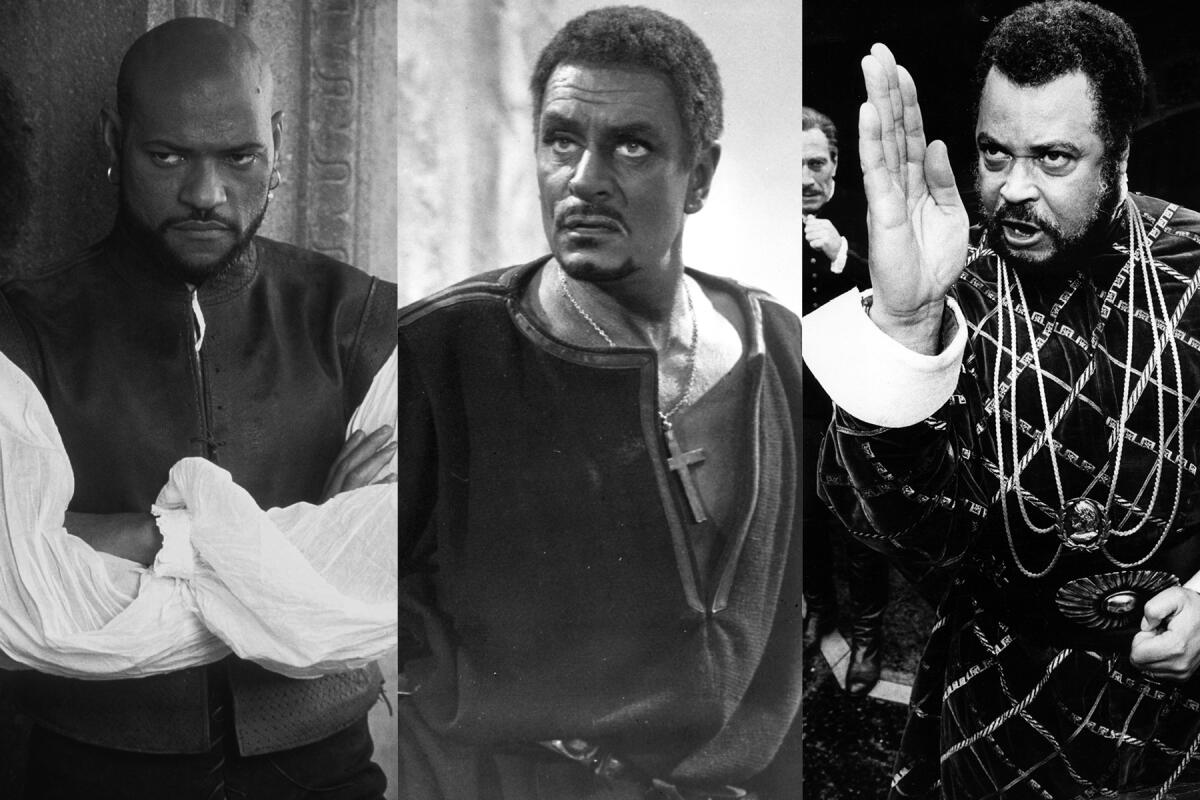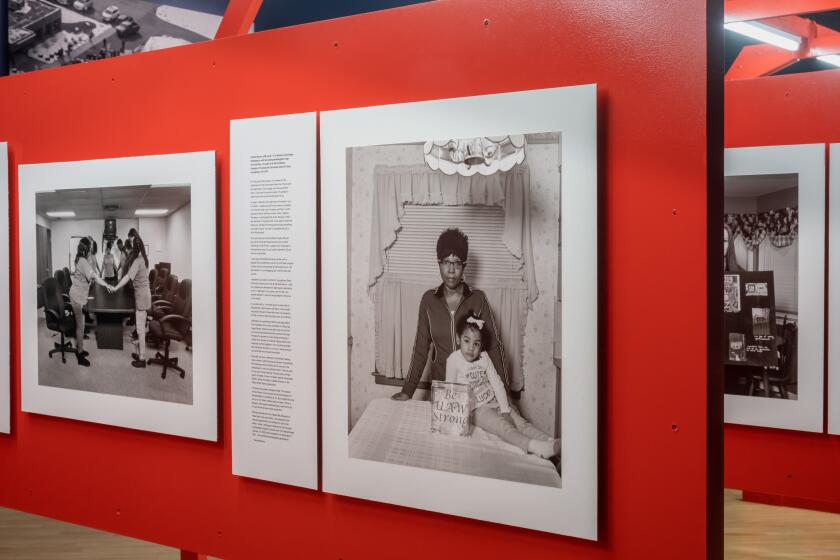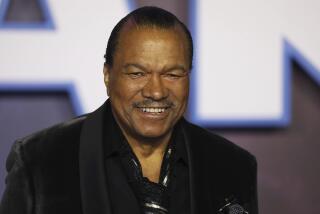Commentary: Must Laurence Olivier’s blackface Othello be banned? I showed the film and wasn’t canceled

Last spring I included in my Shakespeare on Stage and Screen syllabus the 1965 film of “Othello” starring Laurence Olivier in blackface.
You might be wondering why I’m freely acknowledging my academic crime. But if my conscience isn’t clear — and whose can be? — it remains open for inspection.
Unlike composer Bright Sheng, who was compelled to step down from his class at the University of Michigan for showing the Olivier film, I have neither been assailed for racial insensitivity nor held up as a casualty of cancel culture.
I didn’t expose my students at the California Institute of the Arts to the film because I thought it was “one of the most faithful to Shakespeare,” as Sheng, whose class was focused on Verdi’s opera adaptation, told the New York Times. I’m not sure what “faithful to Shakespeare” even means. A film faithful to Elizabethan stagecraft or to an idea of Shakespeare that arose from a later theatrical tradition? Or perhaps just more textually in line than Verdi’s brilliant opera? Who can say? In any case, it was appropriate for Sheng to apologize.
I certainly didn’t include the film because I think it’s a masterpiece. I have a clear memory of my first encounter with the work, which I saw at a decrepit revival house in the East Village one summer night while still in graduate school. I went to check out a performance I had heard only positive things about at drama school. I may have been more curious about seeing a young Maggie Smith than I was the great Olivier, but I was in that stage of my education when I was compulsively checking off boxes.
I lasted maybe 20 minutes in the movie theater. Horrified by Olivier’s racialized prosthetics and West Indian minstrelsy, I fled into the night, angry that anyone could speak reverently about such a repugnant performance.
Dipping back into the writing of Pauline Kael, perhaps the most influential voice in film criticism of my lifetime, I was dismayed to discover this nugget in her 1966 review for McCall’s that she saw fit to anthologize in “For Keeps: 30 Years at the Movies,” published in 1994: “Olivier’s Negro Othello — deep voice with a trace of foreign music in it; happy, thick, self-satisfied laugh; rolling buttocks; grand and barbaric and, yes, a little lewd — almost makes this great, impossible play work.”
The cultural legacy of blackface is still with us. Pop culture manages to regularly get around the taboos, and politicians’ past pranks keep coming back to haunt them. Like it or not, Shakespeare is implicated in this history.
My course was designed to look at multiple interpretations of Shakespeare’s four major tragedies: “Hamlet,” “Othello,” “King Lear” and “Macbeth.” Three weeks of the seminar were devoted to “Othello,” in a journey that moved from page to stage to screen.
The Los Angeles Cultural Affairs Commission approved Destination Crenshaw’s seven inaugural public art projects on Oct. 13. Here’s what to expect.
After a general overview that included a look at the National Theatre’s magnificent 2013 production with Adrian Lester as Othello and Rory Kinnear as Iago in a modern military revival redolent of Middle Eastern wars, we proceeded to discuss performance traditions, which inevitably brought us to the awkward subject of blackface.
Alongside the 1965 Stuart Burge film of John Dexter’s production of “Othello” with an ebony Olivier, I showed scenes from Orson Welles’ 1951 “Othello,” in which Welles wears a dusky shade of makeup, less gleamingly pronounced than Olivier’s shoe polish black but no less unacceptable.
The theatrical merits and deficiencies of these portrayals were discussed in the context of Shakespeare, race and performance. Students were assigned to listen to a Folger Shakespeare Library podcast on the history of Othello and blackface that brought into dialogue two eminent Shakespeare professors, Ayanna Thompson and Ian Smith.
The week before I asked students to read Thompson’s introduction in the Arden Shakespeare “Othello,” which offers an invaluable history of the way the Moor of Venice has been interpreted onstage from the Elizabethan Age to our own. Thompson gives space for the debate among contemporary Black actors about a role that has occasioned many triumphs (most notably, the pioneering work of Paul Robeson) but has also provoked a fair amount of cognitive dissonance.
While some Othello alumni have felt that it was an opportunity to endow the character with a richer and more dignified humanity, others have felt troubled by the prospect of giving flesh and breath to a racial stereotype. Sidney Poitier refused to play the part, bluntly stating that he could not “go on stage and give audiences a Black man who is a dupe.” James Earl Jones, who essayed the role numerous times to great acclaim, cannily used the spotlight to advance the cause of civil rights in America.
One of the curiosities of my Shakespeare theatergoing is that, while “Hamlet” and “King Lear” have tended to overwhelm their interpreters and “Macbeth” is clearly jinxed, “Othello” has had a surprisingly high success rate on the stage.
Documentary photography merges with installation art in a smart, moving exhibition at L.A.’s California African American Museum.
Chiwetel Ejiofor’s Othello in the Donmar Warehouse’s 2007 production remains for me the pinnacle, but Lester’s portrayal in Nicholas Hytner’s National Theatre production is a close second. As for American productions, John Douglas Thompson’s powerhouse turn in the 2009 Theatre for a New Audience revival has pride of place.
To read or to see the play is to necessarily engage the question of Othello’s identity. Shakespeare calls him a Moor, but what this signified to the playwright and to his original audience has elicited fierce debate.
How prominent is race a factor in the play? Should Othello’s color be emphasized or de-emphasized? Is this a psychological tale of jealousy or a metaphysical study of human evil? A domestic comedy incongruously transposed to a wartime setting or yet another tragic tale of a woman victimized by the tyrannical imagination of her insecure male partner?
The characters themselves, Thompson points out, are deeply aware of the power of storytelling. They charm, cajole and con with the magic of their words. But it’s not easy to wrestle control in a play that exists so self-consciously in a state of interpretive flux.
Meaning shifts not only from within but also from without: “Othello” transforms with every turn of the historical lens, making it an unusually contentious site of cultural value and import. Race, a keen source of conflict in the stories a society promulgates about itself, raises these stakes astronomically. As Thompson observes, the “play invites revisions, retellings, appropriations and adaptations because it shows just how powerful it is to control the master narrative.”
The seminar wrapped up its “Othello” series with Laurence Fishburne’s Othello (opposite Kenneth Branagh’s Iago) in Oliver Parker’s slick 1995 film. But the conversation about racial identity and dramatic representation continued, as the students became increasingly aware that it’s not possible to disentangle these subjects when discussing the tragedy.
In “Letting Go of ‘Othello,’” an essay in the Paris Review, performance studies scholar Fred Moten poses a series of radical questions on “the protocols for portraying a character who is always so clearly acting, so consciously performing, so emphatically disappearing?” Does a Black “Othello” endow the role with authenticity or might blackface be truer to the reality of a play written by a white man for a white audience? It’s a shocking thought, but Moten isn’t afraid to wonder whether there’s “anything other than a lie lying beneath Othello’s skin.”
Yet a fictional character has no truth apart from the poetic network from which it is given life. We return to Shakespeare’s play because the story of a courageous and noble immigrant general who marries outside his race, falls under the diabolical spell of a petty and vengeful officer, and ultimately murders his devoted wife continues to grip us.
To judge by the performance record alone, the play still speaks powerfully to us — which is to say, still provokes us to reconsider its potential meanings. There are those who would prefer to minimize the importance of identity politics in the tragedy, to see Othello’s visage in his mind, as Desdemona says she does. But Shakespeare takes pains to emphasize Othello’s racial and cultural difference just as he stresses Shylock’s religious separation in “The Merchant of Venice,” a work even more heavily freighted with controversy.
The choice before us too often gets boiled down to either banning or affirming works from the past — a thumbs-up, thumbs-down approach to history. But plays can be recontextualized, their problematic aspects examined in fresh light, their theatrical legacies sifted for new approaches.
Like much else in polarized America, the debate about academic freedom is dominated by the loudest voices in the room. Detail, nuance and context can’t help getting lost in the din of moral outrage stoked by Twitter, Bill Maher and Fox News. But it’s simplistic to divide the world into those who want to eradicate an artistic heritage that no longer passes political muster and those who are convinced that the woke left has established a reign of terror.
Yes, there are undeniable excesses — and believe me I’m aware of the risks I’m taking by writing this article. But it’s the sensational framing of the conflict that inflames a problem that may exist nowhere as prevalently as in the mind of the media.
Thompson published a monograph this year titled “Blackface” to grapple with a subject that has been incessantly in the news, thanks to Megyn Kelly, Canadian Prime Minister Justin Trudeau and Virginia Gov. Ralph Northam. One of the defenses that she wishes to deconstruct is the pretense of “white innocence” by those public figures either caught with their faces smeared in burned cork or their perspectives benighted with outdated assumptions.
History, in this all-too-familiar apology routine, is solely the burden of the oppressed. Obliviousness of how blackface has been used to subjugate, demean and destroy — yet another form of social privilege — is assumed to be a get out of jail free card.
How can this wall of white innocence be cracked without compounding Black trauma? This is a difficult question, but it’s one that we must collectively try to answer. I don’t think I can bear to show clips of either the Olivier or the Welles “Othello” again. But I won’t pretend that this legacy is so remote that we needn’t bother mentioning it again. Perhaps I’ll just flash a photo of a bizarrely coiffed Anthony Hopkins as the Moor of Venice in the 1981 TV movie to prove the point.
Censorship won’t erase the past. The only way forward is to address what we find objectionable with better questions. Art at its Shakespearean finest isn’t a repository for wisdom but an interrogation of what we think we know. It’s one of the rare opportunities in our polarized world to contemplate how we live and might live as a community.
More to Read
The biggest entertainment stories
Get our big stories about Hollywood, film, television, music, arts, culture and more right in your inbox as soon as they publish.
You may occasionally receive promotional content from the Los Angeles Times.









